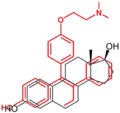Selective estrogen receptor modulator
Selective estrogen receptor modulators (SERMs) are a class of drugs that act on the estrogen receptor. A characteristic that distinguishes these substances from pure agonists and antagonists is that their action is different in various tissues, thereby granting the possibility to selectively inhibit or stimulate estrogen-like action in various tissues.
Mechanism of action
SERMs are competitive partial agonists for the estrogen receptor. They bind to the estrogen receptor and hold it in a conformation that is intermediate between that induced by full agonists and that induced by antagonists. As a result, parts of the receptor binding site that are exposed in the presence of an antagonist, but not in the presence of an agonist, are covered up, and vice versa.
Uses
SERMs are used for various estrogen-related diseases. Tamoxifen is used in the treatment of hormone receptor-positive breast cancer, while raloxifene is used for preventing osteoporosis in postmenopausal women. Other examples of SERMs include clomifene, toremifene, and ospemifene.
Side effects
Possible side effects of SERMs include hot flashes, leg cramps, and an increased risk of blood clots and other cardiovascular events. The risk of endometrial cancer may be slightly increased in women taking tamoxifen.
See also
References
Transform your life with W8MD's budget GLP-1 injections from $125.
W8MD offers a medical weight loss program to lose weight in Philadelphia. Our physician-supervised medical weight loss provides:
- Most insurances accepted or discounted self-pay rates. We will obtain insurance prior authorizations if needed.
- Generic GLP1 weight loss injections from $125 for the starting dose.
- Also offer prescription weight loss medications including Phentermine, Qsymia, Diethylpropion, Contrave etc.
NYC weight loss doctor appointments
Start your NYC weight loss journey today at our NYC medical weight loss and Philadelphia medical weight loss clinics.
- Call 718-946-5500 to lose weight in NYC or for medical weight loss in Philadelphia 215-676-2334.
- Tags:NYC medical weight loss, Philadelphia lose weight Zepbound NYC, Budget GLP1 weight loss injections, Wegovy Philadelphia, Wegovy NYC, Philadelphia medical weight loss, Brookly weight loss and Wegovy NYC
|
WikiMD's Wellness Encyclopedia |
| Let Food Be Thy Medicine Medicine Thy Food - Hippocrates |
Medical Disclaimer: WikiMD is not a substitute for professional medical advice. The information on WikiMD is provided as an information resource only, may be incorrect, outdated or misleading, and is not to be used or relied on for any diagnostic or treatment purposes. Please consult your health care provider before making any healthcare decisions or for guidance about a specific medical condition. WikiMD expressly disclaims responsibility, and shall have no liability, for any damages, loss, injury, or liability whatsoever suffered as a result of your reliance on the information contained in this site. By visiting this site you agree to the foregoing terms and conditions, which may from time to time be changed or supplemented by WikiMD. If you do not agree to the foregoing terms and conditions, you should not enter or use this site. See full disclaimer.
Credits:Most images are courtesy of Wikimedia commons, and templates, categories Wikipedia, licensed under CC BY SA or similar.
Contributors: Prab R. Tumpati, MD










